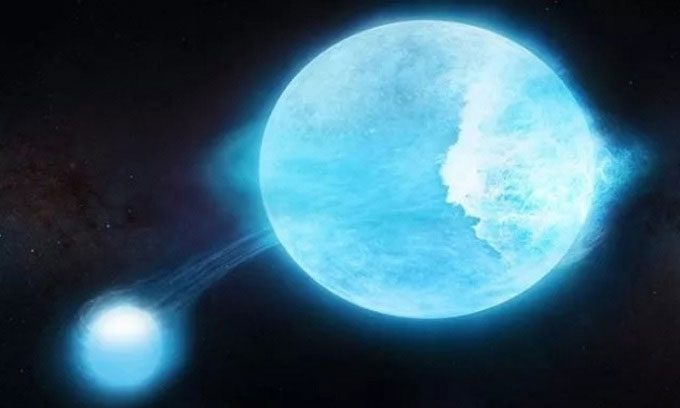Every time a tsunami towering over 4 million kilometers crashes down on the surface of a star, it releases enough energy to shatter Earth hundreds of times.
A giant star is experiencing intense storm waves that are three times higher than the Sun. Nicknamed the “heartbeat star,” this unique celestial body periodically fluctuates in brightness as the gravitational pull from a nearby companion star stretches it into an oblate shape, Space reported on August 15.
In fact, the massive wave of the heartbeat star rises under the influence of the companion star as it approaches in a lengthy 32.8-day elliptical orbit. Similar to how the gravitational pull of the Moon causes tides on Earth by drawing the oceans toward it, the gravity of the companion star attracts material from the heartbeat star and pulls it away at supersonic speeds, creating a super tsunami.

The primary star deformed into an oblate shape in the MACHO 80.7443.1718 system. (Photo: CfA).
The binary star system named MACHO 80.7443.1718 is located 169,000 light-years away from Earth in the Large Magellanic Cloud. The system consists of a primary star with a mass 35 times that of the Sun and a smaller companion star. Although they were first recorded for their varying brightness in 1990, researchers had not discovered any other stars oscillating in such a manner until NASA’s Kepler space telescope became operational and detected dozens of similar stars.
Due to the brightness of the larger star in the system being distorted, they alternately present a wider and narrower face toward Earth, resulting in brightness fluctuations similar to a beating heart. This is why scientists dubbed the star the “heartbeat star.” Typically, the brightness of the heartbeat star varies by 0.1%, but MACHO 80.7443.1718 is always different. Every 32.8 days, it undergoes a regular cycle with brightness increasing by 20%, which is 200 times the variability seen in other heartbeat stars.
By recalling computer models of gas dynamics on the surface of the giant primary star in the system, astrophysicists Morgan MacLeod and Avi Loeb at the Harvard-Smithsonian Center determined that the MACHO 80.7443.1718 system contains not only the heartbeat star due to the plasma waves rising from the companion star crashing down on its surface, releasing extremely powerful energy. “Every time a towering wave crashes onto the star, it releases enough energy to shatter Earth hundreds of times,” MacLeod stated.
The waves on the heartbeat star are incredibly majestic, soaring about 4 million kilometers above its surface. They form when the companion star approaches the periastron, the closest point in its 32.8-day orbit around the primary star. The primary star itself is also massive, with a radius of 16.7 million kilometers, which is 24 times that of the Sun. The outer layer of this giant star is expanding and is weakly held by gravity, making it more susceptible to deformation under the influence of the companion star.
MacLeod and Loeb view the heartbeat star as a natural evolution of closely orbiting binary stars, but the high mass of the primary star seems to exacerbate the situation. Over the long life cycle of stars many times larger than the Sun, the orbits of the two stars gradually become circular, ultimately ending in a series of approaches and deformations. However, massive stars like the primary star in the MACHO 80.7443.1718 system have much shorter lifespans.
For example, MACHO 80.7443.1718 is only 6 million years old and will explode into a supernova within a few million years. In fact, it has ceased hydrogen burning in its core and is moving toward helium fusion, while continuing to burn hydrogen in its outer layers. This is a sign that the star’s death is approaching as it rapidly consumes its fuel, progressing from hydrogen to helium, then to carbon, oxygen, neon, and silicon, and finally to an iron core, peeling off layers like an onion. The chain reaction stops at the iron core.
In this case, the transition from burning hydrogen to helium contributes to the expansion of the star’s outer shell by 2 to 3 times, causing the star to swell and become more influenced by the companion star. The research team published their findings in the journal Nature Astronomy.


















































